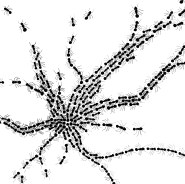
Emergence Theory, Systems Theory/Philosophy:
Indeed, some of the great minds of the last few centuries — Adam Smith, Friedrich Engels, Charles Darwin, Alan Turing — contributed to the unknown science of self-organization, but because the science didn’t exist yet as a recognized field, their work ended up being filed on more familiar shelves. From a certain angle, those taxonomies made sense, because the leading figures of this new discipline didn’t even themselves realize that they were struggling to understand the laws of emergence. They were wrestling with local issues, in clearly defined fields: how ant colonies learn to forage and built nests; why industrial neighborhoods form along class lines; how our minds learn to recognize faces. You can answer all of these questions without resorting to the sciences of complexity and self-organization, but those answers all share a common pattern, as clear as the whorls of a fingerprint. But to see it as a pattern you needed to encounter it in several contexts. Only when the pattern was detected did people begin to think about studying self-organizing systems on their own merits. Keller and Segel saw it in the slime mold assemblages; Jane Jacobs saw it in the formation of city neighborhoods; Marvin Minsky in the distributed networks of the human brain.
What features do all these systems share? In the simplest terms, they solve problems by drawing on masses of relatively stupid elements, rather than a single, intelligent “executive branch.” They are bottom-up systems, not top-down. They get their smarts from below. In a more technical language, they are complex adaptive systems that display emergent behavior. In these systems, agents residing on one scale start producing behavior that lies one scale above them: ants create colonies; urbanites create neighborhoods; simple pattern-recognition software learns how to recommend new books. The movement from low-level rules to higher-level sophistication is what we call emergence.
Steven Johnson, Emergence: the Connected Lives of Ants, Brains, Cities, and Software (2001)
——————————————————————
I felt like drawing ants today, because I woke up to some unnerving ant trails in my kitchen. This reminded me that Emergence is a super good book. I used to teach an excerpt from it in an undergrad writing course, and dang, 98% of college freshmen just really hated it. Mostly because it was difficult, and 98% of people – age aside – do not like difficult things. More than that though, I find that nowadays young people don’t seem to like being told that they are largely ignorant actors in forces larger than themselves, or that there are different kinds of intelligence beyond doing well on your SAT’s. Personally I find it all very comforting with an icing of pretty effing cool on top. But I guess I have a weird pattern-seeking mind, so I would like a book that manages to connect slime mold, ant colonies, brains, and computer software.
If you “zoom out,” the ants look like a little like neurons. Everything is connected, shazaam!

More here: https://www.nytimes.com/2001/09/09/books/chapters/emergence.html
And a thanks goes out to the ant trail maps that inspired this drawing:
https://www.researchgate.net/figure/Trail-networks-of-the-wood-ant-F-aquilonia-and-exploited-resources-studied-at_fig1_225772620
Are you highly learn-ed in specialized knowledge? Are you now, or have you ever been, a graduate student or professor? Do you read dense theoretical texts for fun? Send your favorite theories to devonisadevon@gmail.com, and I will draw them. Esoteric terminology also accepted but will be evaluated on a case-by-case basis. Oh, and follow me on Instagram while you’re at it – devon_isadevon.